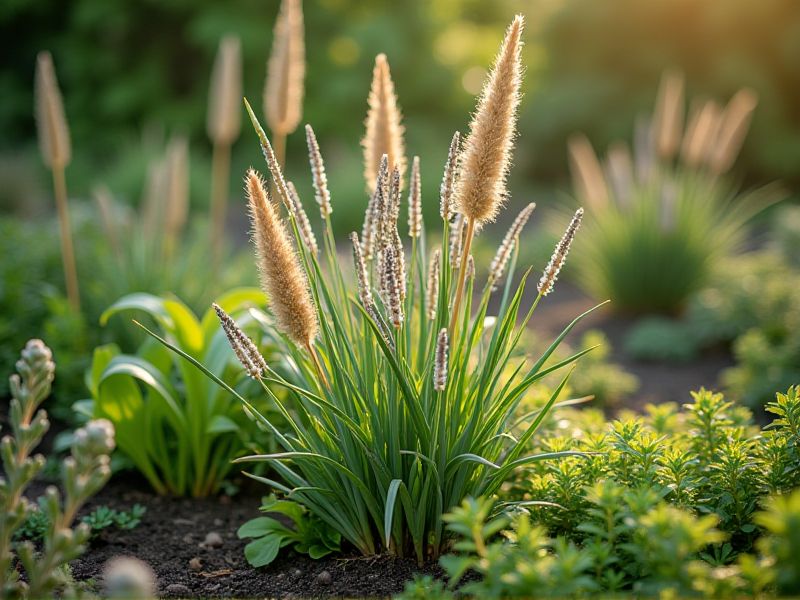
Drought-resistant plants, such as succulents and native grasses, thrive in arid conditions and require minimal watering. Species like Agave, Aloe, and various cacti are well-known for their ability to store water, making them ideal for dry landscapes. These plants often feature deep root systems that access moisture from the soil, enhancing their survival during extended dry periods. Implementing xeriscaping practices in your garden can further promote water conservation while showcasing these resilient varieties. By choosing drought-tolerant plants, you not only reduce water usage but also support local ecosystems.
List of some Drought-resistant plants that require little water
- Lavender (*Lavandula*)
- Rosemary (*Rosmarinus officinalis*)
- Aloe Vera (*Aloe barbadensis miller*)
- Agave (*Agave americana*)
- Sage (*Salvia officinalis*)
- Yucca (*Yucca filamentosa*)
- Sedum (*Sedum spp.*)
- Russian Sage (*Perovskia atriplicifolia*)
- Coneflower (*Echinacea purpurea*)
- Cactus (*Cactaceae*)
Important things about Drought-resistant plants that require little water
Native Species Adaptability
Drought-resistant plants, such as succulents and native grasses, possess unique adaptations that enable them to thrive in arid environments with minimal water. These species often have deep-root systems that access groundwater and specialized leaves that minimize water loss through transpiration. Understanding these adaptations is crucial for gardeners and landscapers who aim to create sustainable, low-water landscapes. By incorporating such plants, you can significantly reduce water usage in your garden while supporting local biodiversity and promoting ecological balance.
Deep Root Systems
Drought-resistant plants, characterized by deep root systems, are essential for surviving in arid conditions where water scarcity is a concern. These plants, such as mesquite trees and succulents, have adapted to reach underground water sources, allowing them to thrive even during prolonged dry spells. By investing in drought-resistant landscaping, you can create a sustainable garden that conserves water and supports local ecosystems. Incorporating these resilient species not only reduces maintenance needs but also enhances biodiversity and soil health.
Succulent Storage Capabilities
Drought-resistant plants, such as succulents, possess specialized adaptations that enable them to store water efficiently, making them ideal for arid environments. These plants have fleshy leaves or stems that act as natural reservoirs, capturing moisture during brief rainfall or high humidity. Your garden can flourish with species like Aloe Vera, Agave, and Echeveria, which thrive on minimal water while providing aesthetic beauty. Proper care involves placing them in well-draining soil and ensuring they receive ample sunlight, enhancing their longevity and resilience in drier climates.
Drought-Tolerant Foliage
Drought-resistant plants, such as succulents and native perennials, are ideal for water-wise gardening, offering vibrant options that thrive with minimal irrigation. Species like Agave, Lavender, and ornamental grasses not only conserve water but also attract pollinators, enriching your garden ecosystem. Selecting these hardy plants can significantly reduce maintenance time and resources, making them a sustainable choice for arid climates. By incorporating a variety of drought-tolerant foliage, you create an eye-catching landscape while promoting environmental sustainability.
Minimal Maintenance Requirements
Drought-resistant plants, such as succulents, lavender, and ornamental grasses, thrive in arid conditions and require minimal water, making them ideal for conserving resources and maintaining a sustainable garden. These hardy species have adapted features such as thick leaves or deep root systems, allowing them to store moisture efficiently. By incorporating these plants into your landscape, you can create a vibrant, low-maintenance garden that flourishes even in dry climates. Utilizing drought-resistant plants not only reduces your water consumption but also supports local biodiversity and improves soil health.
Efficient Water Use
Drought-resistant plants, such as succulents, agaves, and native xerophytes, thrive in arid conditions while requiring minimal water for sustenance. These plants feature specialized adaptations, including thickened leaves that store moisture and deep root systems that penetrate soil to access underground water sources. Incorporating drought-resistant varieties in your landscape not only conserves water but also reduces maintenance needs, making for a sustainable gardening choice. By selecting these resilient species, you contribute significantly to water conservation efforts and promote biodiversity in your local ecosystem.
Heat Resilience
Drought-resistant plants, such as succulents and native grasses, are expertly adapted to thrive in arid conditions with minimal water. These species have unique physiological traits, like thickened leaves and deep root systems, allowing them to store moisture and access underground water sources. Incorporating drought-tolerant plants into your landscape not only conserves water but also promotes biodiversity and reduces maintenance efforts. With options like lavender and agave, you can create a vibrant, eco-friendly garden that withstands heat and drought effectively.
Soil Improvement Benefits
Implementing drought-resistant plants in your landscape can significantly enhance soil health and reduce water usage. These plants, such as succulents and native flora, are specifically adapted to thrive in arid conditions, helping to stabilize the soil structure and prevent erosion. By adding organic matter through composting, you can further improve the soil's capacity to retain moisture. Adopting this sustainable practice not only conserves water resources but also supports local ecosystems and promotes biodiversity.
Aesthetic Variety
Drought-resistant plants, also known as xerophytes, exhibit a remarkable ability to thrive in arid conditions with minimal water requirements. Succulents, like Aloe Vera and Agave, store moisture in their leaves, making them ideal for low-water landscapes. Native grasses, such as Buffalo Grass and Blue Grama, not only enhance the ecological balance but also create visually appealing ground cover. Incorporating these resilient species into your garden not only conserves water but also adds a unique aesthetic variety, ensuring that your outdoor space remains vibrant even in drier climates.
Environmental Conservation Impact
Drought-resistant plants, such as succulents and xerophytes, play a crucial role in environmental conservation by minimizing water usage and promoting sustainable landscaping. These resilient species are adapted to arid conditions, showcasing unique adaptations like thick, fleshy leaves that store moisture, allowing them to thrive in water-scarce environments. Incorporating drought-resistant plants into your garden not only conserves water but also supports local ecosystems by providing habitats for various wildlife. By choosing native drought-tolerant flora, you contribute to reducing the overall ecological footprint while enhancing the beauty and resilience of your outdoor spaces.
